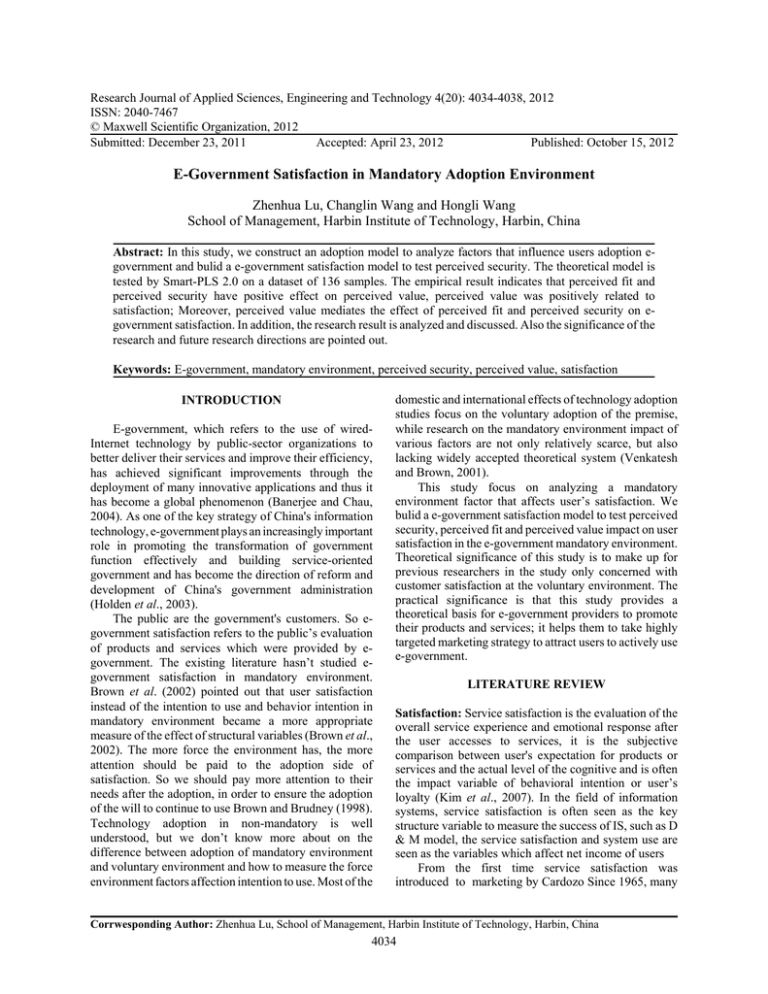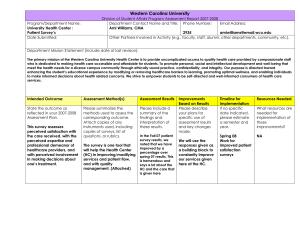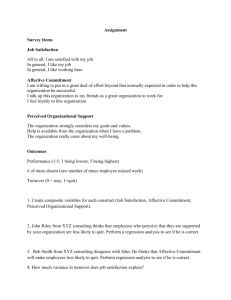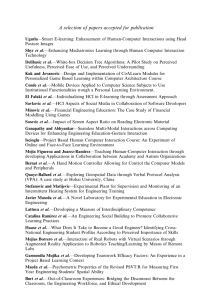Research Journal of Applied Sciences, Engineering and Technology 4(20): 4034-4038,... ISSN: 2040-7467
advertisement

Research Journal of Applied Sciences, Engineering and Technology 4(20): 4034-4038, 2012 ISSN: 2040-7467 © Maxwell Scientific Organization, 2012 Submitted: December 23, 2011 Accepted: April 23, 2012 Published: October 15, 2012 E-Government Satisfaction in Mandatory Adoption Environment Zhenhua Lu, Changlin Wang and Hongli Wang School of Management, Harbin Institute of Technology, Harbin, China Abstract: In this study, we construct an adoption model to analyze factors that influence users adoption egovernment and bulid a e-government satisfaction model to test perceived security. The theoretical model is tested by Smart-PLS 2.0 on a dataset of 136 samples. The empirical result indicates that perceived fit and perceived security have positive effect on perceived value, perceived value was positively related to satisfaction; Moreover, perceived value mediates the effect of perceived fit and perceived security on egovernment satisfaction. In addition, the research result is analyzed and discussed. Also the significance of the research and future research directions are pointed out. Keywords: E-government, mandatory environment, perceived security, perceived value, satisfaction INTRODUCTION E-government, which refers to the use of wiredInternet technology by public-sector organizations to better deliver their services and improve their efficiency, has achieved significant improvements through the deployment of many innovative applications and thus it has become a global phenomenon (Banerjee and Chau, 2004). As one of the key strategy of China's information technology, e-government plays an increasingly important role in promoting the transformation of government function effectively and building service-oriented government and has become the direction of reform and development of China's government administration (Holden et al., 2003). The public are the government's customers. So egovernment satisfaction refers to the public’s evaluation of products and services which were provided by egovernment. The existing literature hasn’t studied egovernment satisfaction in mandatory environment. Brown et al. (2002) pointed out that user satisfaction instead of the intention to use and behavior intention in mandatory environment became a more appropriate measure of the effect of structural variables (Brown et al., 2002). The more force the environment has, the more attention should be paid to the adoption side of satisfaction. So we should pay more attention to their needs after the adoption, in order to ensure the adoption of the will to continue to use Brown and Brudney (1998). Technology adoption in non-mandatory is well understood, but we don’t know more about on the difference between adoption of mandatory environment and voluntary environment and how to measure the force environment factors affection intention to use. Most of the domestic and international effects of technology adoption studies focus on the voluntary adoption of the premise, while research on the mandatory environment impact of various factors are not only relatively scarce, but also lacking widely accepted theoretical system (Venkatesh and Brown, 2001). This study focus on analyzing a mandatory environment factor that affects user’s satisfaction. We bulid a e-government satisfaction model to test perceived security, perceived fit and perceived value impact on user satisfaction in the e-government mandatory environment. Theoretical significance of this study is to make up for previous researchers in the study only concerned with customer satisfaction at the voluntary environment. The practical significance is that this study provides a theoretical basis for e-government providers to promote their products and services; it helps them to take highly targeted marketing strategy to attract users to actively use e-government. LITERATURE REVIEW Satisfaction: Service satisfaction is the evaluation of the overall service experience and emotional response after the user accesses to services, it is the subjective comparison between user's expectation for products or services and the actual level of the cognitive and is often the impact variable of behavioral intention or user’s loyalty (Kim et al., 2007). In the field of information systems, service satisfaction is often seen as the key structure variable to measure the success of IS, such as D & M model, the service satisfaction and system use are seen as the variables which affect net income of users From the first time service satisfaction was introduced to marketing by Cardozo Since 1965, many Corrwesponding Author: Zhenhua Lu, School of Management, Harbin Institute of Technology, Harbin, China 4034 Res. J. Appl. Sci. Eng. Technol., 4(20): 4034-4038, 2012 scholars have made a lot of researches on satisfaction from different point of view. These studies roughly divided satisfaction into the following four categories: C C C C The satisfaction of a particular transaction type: Service satisfaction is limited to the evaluation of particular purchase; the satisfaction of particular transaction type can provide specific diagnostic information for a specific product or service transaction. In a specific environment service satisfaction is an immediate emotional response for the value of the product obtained from using the product, such as literature. The cumulative type satisfaction: Cumulative-type is the overall evaluation for some products or all accumulated experience of service, the cumulative type satisfaction reminds companies to increase their products or services to improve customer satisfaction, Such as literature. Cognitive evaluation of satisfaction: Cognitive evaluation of customer satisfaction is the cognitive process of evaluation that is a comparison between the cognitive performance acquired in the actual product or service and the prior expectation of the product or service, such as literature. Feelings of satisfaction: Emotional satisfaction is defined as customer’s satisfaction and subjective resulting satisfaction and vice versa, such as literature. Satisfaction with e-government services can be defined from the following four areas: the service target is the public; the service content is the e-services provided by the government; service platform is the network system provided by the government t; satisfaction formation process includes input, service process and output stages. Chan et al. (2010) considers that in the mandatory condition service satisfaction substituting the service will of users be more reasonable. Based on UTAUT theory, the authors studied factors of adopt smart card through empirical study. (Magoutas and Mentzas, 2007) gives out a case to present a comprehensive model to assess public satisfaction with the impact of e-government factors which include internal means of communication, service reliability, support mechanisms, ease of use and security way through a case. Verdegem and Verleye (2009) considers that the public can measure from multiple dimensions to their satisfaction when using the egovernment. Welch (2005) discussed relations between satisfaction in public e-government and public trust in government. Technology acceptance model: In 1989, Davis put out to the Technology Acceptance Model (TAM), which is using rational behavior theory to study user’s acceptance of information systems. It was originally intended to explain for the crucial factor of why computer were widely accepted. Technology acceptance model proposed two major determinants: C C Perceived usefulness reflects a person thinks how much he can increase the content of his job performance with a specific system; Perceived ease of use reflects a person thinks that it is easy to use a specific system level. Technology acceptance model believes that the system is decided by behavioral intention and behavioral intention to use by the attitude and perceived usefulness of co-decision, attitude to use is co-decided by the perceived usefulness and perceived ease of use, perceived usefulness is co-decided by perceived ease and external variables, perceived ease of use is determined by external variables. External variables includes system design characteristics, users’ characteristics (including the perception of form and other personality characteristics), task characteristics, the nature of the development or implementation, policy implications, organizational structure, etc., as the technology acceptance model in the presence of internal beliefs, attitudes, intentions and the differences between different individuals, environmental constraints, the interference can be controlled to establish a link between the factors. Attitude refers to the use of individual users when using the system subjectively positive or negative feelings. Behavior will be used to accomplish specific acts of individual will to the measurable level. The model believes that the use of the target system is mainly determined by the individual user's behavior intention, behavioral intention was decided by the attitude and the usefulness of using, attitudes were decided by the perceived usefulness and perceived ease of use, perceived usefulness is decided by the external variables and perceived ease of use, perceived ease of use is determined by external variables. External variable is the number of measurable factor, such as system training time, user manuals and system design features of the system itself. Customer satisfaction in the mandatory environment: While most of prior researches are about technology adoption in voluntary use environment, Brown et al. (2002) pointed out that present models were not appropriate to explain technology acceptance in mandatory use contexts. In particular, Brown et al. (2002) indicated that the traditional notion of “use” was not the right dependent variable in mandatory use settings because users must use the system to fulfill their job 4035 Res. J. Appl. Sci. Eng. Technol., 4(20): 4034-4038, 2012 PS PV SA PF PS = perceived security; PF = perceived fit PV = perceived value; SA = Satisfaction Fig. 1: Research model functions and there were no other options to use the system. What’s more, Brown et al. (2002) found that users’ attitudes to use a kind of technology and their intentions to use that technology were not related in mandated use environments. They pointed out that intention to use a technology might be related more to other beliefs, such as the related rewards and punishments, than to beliefs about the technology. So, examining intentions and their antecedents may make organizations focus on less relevant factors. User’s satisfaction, instead of the behavioral intention to use the system, is more appropriate dependent variable when the system in question is in large scale and integrated and its use is mandated. As user’s satisfaction is widely recognized as a significant advantage of IS success, understanding factors, including expectations and experiences of using the system, which influence user’s satisfaction has important implications for organizations. Research model: Based on the analysis of the second part, we have gotten the model of this study shown in Fig. 1. The users think perception security is the cognition that the use of a particular system the zero level of risk assumed. In the context of e-government, reflecting the perceived safety of users of e-government services, reliability and privacy awareness, are the trust service providers and users have to use the system and act as important factors. Typically, the perception of security measures with the perceived reliability, perceived reliability refers to the privacy of users believe the system does not use or disclose the hidden extent of the losses will not be at risk. More and more studies show that users’ first and foremost consideration in the use of information systems is the safety. When the user thinks that the use of the system will not threaten their privacy, they will increase awareness of the usefulness of the system, thereby increase the perceived value of the system, thus holds a positive attitude. Therefore, the user’s adoption of e-government, we give the following two assumptions: H1: Significant effect on perceived safety perception fit H2: Significant effect on perceived security of the perceived value In the technology adoption model, the external variables on perceived usefulness and perceived ease of use have a major impact. In this study, TAM model has been improved, we use the perception of the matching variables in the TAM model to replace the external variables. Lack of security measures and failing to establish effective privacy protection mechanism have become obstacles to the development of online trading and have a negative impact on e-government. When the user perceived the system better able to help them complete their work, the user will perceive the value of the system. As users of e-government understanding of the gradual deepening and strengthening the breadth and depth of use and its increasing role in promoting the work, the user will increase satisfaction with the system. As a result, we give the hypothesis 3 and hypothesis 4: H3: Significant effect on perception fit the perceived value H4: Significant impact on perceived fit user satisfaction The service management literature argues that customer satisfaction is the result of customer perception of value received. Perceived Value is considered ‘a cognitive-based construct that captures any benefitsacrifice discrepancy in much the same way disconfirmation does for variations between expectations and perceived performance. However, Satisfaction is primarily an affective evaluative response. In egovernment context, cognition-oriented value appraisal precedes the effect-oriented satisfaction response. There also exists empirical support for the effect of Perceived Value on User Satisfaction. Thus, the following hypothesis is tested: H5: Significant impact on the perceived value of user satisfaction RESEARCH METHODOLOGY We collect data to validate the research model in Fig. 2 Through the issuance of questionnaires. For the reliability and validity of all variables in the model, we take measurements of these variables based on the analysis in the literature, drawing on existing research PS 0.344** 0.410** 0.291** 0.371** PF PV SA 0.277** PS = perceived security; PF = perceived fit ; PV = perceived value ; SA = Satisfaction Fig. 2: Research model 4036 Res. J. Appl. Sci. Eng. Technol., 4(20): 4034-4038, 2012 Table 1: Cross loadings IN PS1 0.8007 PS2 0.9017 PS3 0.9164 PF1 0.3894 PF2 0.1123 PF3 0.261 PV1 0.4109 PV2 0.3773 PV3 0.3145 SA1 0.3684 SA2 0.2912 SA3 0.1954 Table 2: Reliability AVE PS 0.7647 PF 0.8023 PV 0.7610 SA 0.7713 PF PS PU 0.8697 0.8949 0.9217 0.379 0.2996 0.2884 0.4435 0.3416 0.337 0.8241 0.9213 0.869 0.4691 0.421 0.4584 0.8989 0.8657 0.8697 CR 0.9067 0.9241 0.9051 0.9100 Table 4: Total effect Hypothesis Or. S PS -> PF 0.2907 PS -> PV 0.423 PF -> PV 0.2709 PF -> SA 0.3884 PV -> SA 0.4098 Mean 0.3022 0.4318 0.2701 0.3924 0.4062 Cranach’s " 0.8450 0.8767 0.8417 0.8521 R2 0.0000 0.0845 0.2461 0.3292 Table 3: Latent variable correlations PS PF PS 0.8745 PF 0.2907 0.8957 PV 0.4230 0.3709 SA 0.3282 0.429 SD 0.0553 0.0494 0.0457 0.0720 0.0541 0.5, Composite Reliability (CR) above 0.7 is acceptable. As can be seen from Table 1, AVE values are all above 0.7, CR values are all above 0.9, indicating that each item has a high measure of convergent validity and good internal consistency (Table 2). From Table 1 we can see that factor loadings measuring issues relevant problem of structure variable are all above 0.7 and the latent variable explains 70% of the variance. Generally it is believed that the cumulative explained variance of extracted factor are more appropriate when they are in 70-80%. In order to verify the identification validity of it, we need square root AVE values. If the square root of the AVE is the biggest factor in its internal structure, that is, the square root of AVE values bigger than their correlation with other factors, indicating that the measurement model has good discriminant validity. As shown in Table 3, the AVE square root of each factor (shaded figuresinthe Table) are larger than the corresponding correlation coefficient (the other values of the same columns), so different factors have a good validity among them. PV SA 0.8724 40.5127 0.8782 T 5.2610 8.5636 5.9289 5.3922 7.5773 Results support support support support support literature. These scales are directly translated into Chinese and we do some modifications of the expression on the basis of research needs and the specific environment of China. Based on the literature on the study of metrics for each variable, we designed a Likert 7-level measure of the questionnaire, options for each question varify from strongly disagree (1) to strongly agree (7), users according to their specific and use of scoring. Perceptual Fit (PF) from, Perceived Security (PS) measure from, Perceived Value (PV) measure from and Satisfaction (SA). In order to ensure the validity of questionnaire design, we made a pre-paid in advance before the survey. According to the feedback results of 50 collected questionnaires, the expression which might be misunderstood and academic language had been modified. After the modifications were completed, we then extracted the 300 enterprises in Henan Province to use the Golden Tax Project, inviting them to participate in online surveys, 156 questionnaires, 20 removed because the data were incomplete, the final 136 valid questionnaires. Data analysis: Measurement model: Studies have shown that the Average Extracted Variance of variables (AVE) is above Path model: Figure 2 shows the verified results of the six hypothesis that operated by PLS, in which, the independent variable IN’s R2 = 0.329. Generally speaking, we can conclude that the interpretation from model to dependent variable is strong when the value of R2 is above 0.3. Specifically, the total evaluation of model as Table 4, all t value are significant, we can conclude that five hypothesises are surpported. RESULTS AND DISCUSSION The impact of perceived security: Internet security should not be ignored by the majority of Internet users and the government. Our research shows that perceived security is the most important factor of the perceived value and perceived fit. This shows that in the process of using e-government service, the user wishes to egovernment service providers could protect their privacy and their security awareness on the use directly affects the value of e-government awareness. This gives us the revelation is that the user’s good perception of security would largely increase user’s awareness of the value of egovernment. Therefore, governments and enterprises should consider how to improve the safety use of egovernment, so that promote the value of mobile government. The influence of perceived fit: Perceived fit is an important factor affecting perceived value and customer’s satisfaction. This study reaches a different conclusion 4037 Res. J. Appl. Sci. Eng. Technol., 4(20): 4034-4038, 2012 with the Goodhue previous studies. We believe that the two different conclusions may be attributed to Goodhue ignoring the many variables effect on user’s satisfaction. We find that perceived fit positively affect perceived value and customer satisfaction, which indicates that before the user uses of a new technology, it is focusing on whether the technology can support their work, whether product positively affects their work and whether the system security is guaranteed. This gives providers to bring e-government a lesson, when they developing new products or new services, they need to combine the characteristics of tasks, focusing on product availability, in order to ensure that products and services can give customers a good use experience. The impact of perceived value on customer satisfaction: Obvious effect of the perceived value on customer satisfaction also partly confirmed the classic model of TAM and IS success model. Whether TAM model or IS model, the user's perceived value have a strong influence on his intention to use. This shows that the perceived value is an important variable to predict the user wishes, when the user perception of e-government can support their work tasks, the user may actively use of e-government. Therefore, mobile service providers need to continuously improve service levels, enhance the userrelated information (e.g., privacy or other sensitive personal information) protection. Meanwhile, they can multi-layerly attract more users to use e-government by raising the cost performance, using different types of marketing strategy for different users, from the more positive aspects to attract more users. CONCLUSION Based on the TAM model, we bulid a e-government satisfaction model to test perceived security, perceived fit and perceived value impact on user satisfaction in the egovernment mandatory environment. Theoretical significance of this study is to make up for previous researchers in the study only concerned with customer satisfaction at the voluntary environment, we open up a new perspective for future research, which will give some guidance for improving e-government. The practical significance is that this study provides a theoretical basis for e-government providers to promote their products and services; it helps them to take highly targeted marketing strategy to attract users to actively use e-government. The main limitation of this study is that the sample response rate is too low. What’s more, trust and service quality are also important factors of user satisfaction. In the future, we also need to introduce these factors into the model in order to enhance the explanatory power of this model. Finally cross-sectional data can also be used to verify the model in order to further enhance the model's explanatory power. ACKNOWLEDGMENT This study was supported by Project 71028033 of the National Science Foundation of China. REFERENCES Banerjee, P. and Y. Chau, 2004. An evaluative framework for analyzing e-government convergence capability in developing countries. Electr. Govern., 1(1): 29-48. Brown, S.A., A.P. Massey, M.M. Montoya-Weiss and J.R. Burkman, 2002. Do I really have to? User acceptance of mandated technology. Europ. J. Inform. Syst., 11(4): 283-295. Brown, M.M. and J.L. Brudney, 1998. A smarter, cheaper and faster government? Contract. Geograp. Inform. Syst. Pub. Admin. Rev., 58(3): 335-345. Holden, S., D. Norris and P. Fletcher, 2003. Electronic government at the local level: Progress to date and future issues. Pub. Perform. Manage. Rev., 26(3): 1-20. Kim, H., H. Chan and S. Gupta, 2007. Value-based adoption of mobile internet: An empirical iinvestigation. Decis. Supp. Syst., 43(1): 111-126. Venkatesh, V. and S.A. Brown, 2001. A longitudinal investigation of personal computers in homes: Adoption determinants and emerging challenges. MIS Quart., 25(1): 71-102. Chan, F.K.Y., J.Y.L. Thong, V. Venkatesh, S.A. Brown, P.J. Hu and K.Y. Tam, 2010. Modeling citizen satisfaction with mandatory adoption of an egovernment technology. J. Assoc. Inf. Syst., 11(10): 519-549. Magoutas, B. and G. Mentzas, 2007. The Role of Adaptivity and Personalization technologies in Eparticipation. (Online) Demo-net: The eParticipation Networke. Retrieved from: http:// www.demo-net.org/what-is-it-about/research-papersreports-1/demo-net-deliverables/pdfs/d143AdaptivityPersonalization.pdf (Accessed on: October 7th, 2010). Verdegem, P. and G. Verleye, 2009. User-centered egovernment in practice: A comprehensive model for measuring user satisfaction. Gov. Inform. Q., 26(3): 487-497. Welch, E.W., C.C. Hinnant and M.J. Moon, 2005. Linking citizen satisfaction with e-government and trust in Government. J. Public Adm. Res. Theory, 15(3): 371-391, Doi: 10.1093/jopart/mui021. 4038







